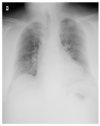The Successful Recovery of a Critically Ill COVID-19 Patient, Following the Combination of Therapeutic Plasma Exchange and Convalescent Plasma Transfusion: A Case Report
- PMID: 36013555
- PMCID: PMC9416755
- DOI: 10.3390/medicina58081088
The Successful Recovery of a Critically Ill COVID-19 Patient, Following the Combination of Therapeutic Plasma Exchange and Convalescent Plasma Transfusion: A Case Report
Abstract
With an intricate symptom pattern involving a dysregulated host response to infection, the severe acute respiratory syndrome coronavirus 2 (SARS-CoV-2) can cause severe inflammation and cytokine storms, acute respiratory distress syndrome, coagulopathy, multi-organ failure, and finally death. The uniqueness of this case report lies in the nature of the therapeutic intervention performed. While numerous studies are available on both the use of therapeutic plasma exchange in coronavirus disease 2019 (COVID-19) patients and convalescent plasma transfusion as separate treatment methods, there is very little information regarding the combination of these procedures. We present the case of a 52-year-old male, unvaccinated for COVID-19, who tested positive on reverse transcriptase polymerase chain reaction for SARS-CoV-2 for the first time and presented in the emergency room with fever, chills, severe cough, tachypnea, tachycardia, and dyspnea that started two days before presentation. Upon rapid assessment, the patient showed signs of acute respiratory failure, so it was decided to transfer the patient to the intensive care unit, COVID-19 ward, after preliminary radiological examination. For the next 24 days, the patient was stationed in the intensive care unit, where he was closely monitored and treated. Invasive mechanical ventilation was required following the initial worsening of his respiratory status. We performed therapeutic plasma exchange on the first day of his stay in the intensive care unit, and immediately after the procedure, the patient was transfused with 500 mL of convalescent plasma from healthy donors. The patient's condition improved over the next few days, which led to the cessation of mechanical ventilation and, after treating the superinfection, the patient was discharged home, making a full recovery. The early initiation of therapeutic plasma exchange followed by transfusion of convalescent plasma in severe and critical forms of COVID-19 may reduce the risk of the progression of the disease and ultimately reduce the risk of negative outcomes in a selected group of patients.
Keywords: COVID-19; case report; convalescent plasma transfusion; therapeutic plasma exchange.
Conflict of interest statement
The authors declare no conflict of interest.
Figures




Similar articles
-
Treatment of 5 Critically Ill Patients With COVID-19 With Convalescent Plasma.JAMA. 2020 Apr 28;323(16):1582-1589. doi: 10.1001/jama.2020.4783. JAMA. 2020. PMID: 32219428 Free PMC article.
-
Randomized clinical trial to evaluate safety and efficacy of convalescent plasma use among hospitalized patients with COVID-19 (PERUCONPLASMA): a structured summary of a study protocol for a randomized controlled trial.Trials. 2021 May 17;22(1):342. doi: 10.1186/s13063-021-05189-6. Trials. 2021. PMID: 34001174 Free PMC article.
-
Convalescent plasma or hyperimmune immunoglobulin for people with COVID-19: a rapid review.Cochrane Database Syst Rev. 2020 May 14;5(5):CD013600. doi: 10.1002/14651858.CD013600. Cochrane Database Syst Rev. 2020. Update in: Cochrane Database Syst Rev. 2020 Jul 10;7:CD013600. doi: 10.1002/14651858.CD013600.pub2. PMID: 32406927 Free PMC article. Updated.
-
Reconvalescent plasma/camostat mesylate in early SARS-CoV-2 Q-PCR positive high-risk individuals (RES-Q-HR): a structured summary of a study protocol for a randomized controlled trial.Trials. 2021 May 17;22(1):343. doi: 10.1186/s13063-021-05181-0. Trials. 2021. PMID: 34001215 Free PMC article.
-
Convalescent Plasma Therapy in Late-State, Severe COVID-19 Infection.South Med J. 2023 May;116(5):427-433. doi: 10.14423/SMJ.0000000000001546. South Med J. 2023. PMID: 37137479 Free PMC article. Review.
Cited by
-
Effectiveness of COVID-19 Convalescent Plasma (CCP) During the Pandemic Era: A Literature Review.J Blood Med. 2023 Feb 22;14:159-187. doi: 10.2147/JBM.S397722. eCollection 2023. J Blood Med. 2023. PMID: 36855559 Free PMC article. Review.
-
Therapeutic plasma exchange accelerates immune cell recovery in severe COVID-19.Front Immunol. 2025 Jan 17;15:1492672. doi: 10.3389/fimmu.2024.1492672. eCollection 2024. Front Immunol. 2025. PMID: 39896810 Free PMC article. Clinical Trial.
References
-
- Li L., Zhang W., Hu Y., Tong X., Zheng S., Yang J., Kong Y., Ren L., Wei Q., Mei H., et al. Effect of convalescent plasma therapy on time to clinical improvement in patients with severe and life-threatening COVID-19: A randomized clinical trial. JAMA. 2020;324:460–470. doi: 10.1001/jama.2020.10044. - DOI - PMC - PubMed
Publication types
MeSH terms
LinkOut - more resources
Full Text Sources
Medical
Miscellaneous

